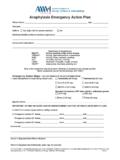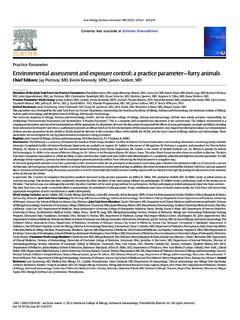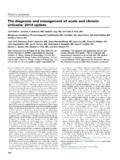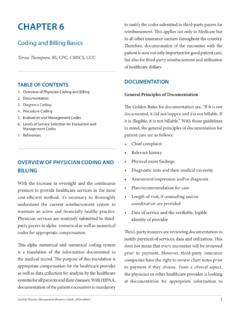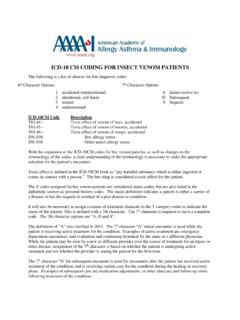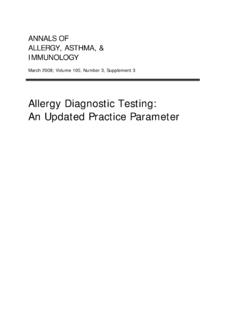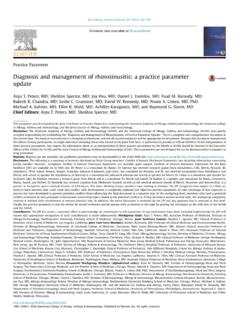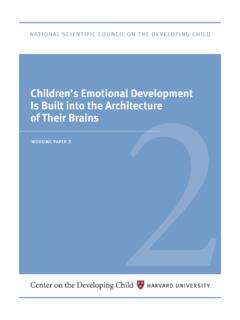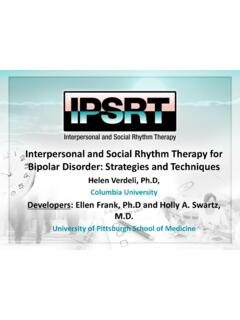Transcription of Conducting an Oral Food Challenge: An Update to the 2009 ...
1 AAAAI Work Group ReportConducting an Oral Food Challenge: An Update tothe 2009 Adverse Reactions to Foods CommitteeWork Group ReportJ. Andrew Bird, MDa, Stephanie Leonard, MDb,c, Marion Groetch, MS, RDNd, Amal Assa ad, MDe,Antonella Cianferoni, MD, PhDf, April Clark, RDN, LDg, Maria Crain, APRN, CPNPg, Tracy Fausnight, MDh,David Fleischer, MDi,j, Todd Green, MDk, Matthew Greenhawt, MD, MBA, MSci,j, Linda Herbert, PhDl,m,Bruce J. Lanser, MDn, Irene Mikhail, MDo, Shahzad Mustafa, MDp,q, Sally Noone, RNd, Christopher Parrish, MDa,Pooja Varshney, MDr,s, Berber Vlieg-Boerstra, RD, PhDt,u, Michael C. Young, MDv, Scott Sicherer, MDd, andAnna Nowak-Wegrzyn, MD, PhDwDallas and Austin, Texas; San Diego, Calif; New York and Rochester, NY; Cincinnati andColumbus, Ohio; Philadelphia, Hershey, and pittsburgh , Pa; Denver and Aurora, Colo; Washington, DC; Amsterdam and Groningen,The Netherlands; and Boston, MassAAAAI Position Statements, Work Group Reports, and Systematic Reviews are not to be considered to reflect current AAAAI standards or policy after five years from the date of publication.
2 The statement below is not to be construed as dictating an exclusivecourse of action nor is it intended to replace the medical judgment of healthcare professionals. The unique circumstances of individualpatients and environments are to be taken into account in any diagnosis and treatment plan. The statement reflects clinical andscientific advances as of the date of publication and is subject to reference food challenges are an integral part of an allergist s practiceand are used to evaluate the presence or absence of allergicreactivity to foods. A work group within the Adverse Reactionsto Foods Committee of the American Academy of Allergy,Asthma & Immunology was formed to Update a previouslypublished oral food challenge report. The intention of thisdocument was to supplement the previous publication withadditional focus on safety, treatment of IgE-mediated allergicreactions, guidance for challenges in infants and adults,psychosocial considerations for children and familiesparticipating in an oral food challenge, specific guidance forbaked milk or baked egg challenges, masking agents andvalidated blinding recipes for common food allergens, andrecommendations for Conducting and interpreting challenges inaUniversity of Texas Southwestern Medical Center, Dallas, TexasbUniversity of California, San Diego, CalifcRady Children s Hospital, San Diego, CalifdJaffe Food Allergy Institute, Icahn school of medicine at Mount Sinai, New York, NYeCincinnati Children s Hospital Medical Center, Cincinnati, OhiofPerelman school of medicine , university of Pennsylvania, Philadelphia.
3 PagChildren s Health, Dallas, TexashPenn State College of medicine , Hershey, PaiChildren s Hospital Colorado, Denver, ColojUniversity of Colorado school of medicine , Aurora, ColokUPMC Children s Hospital of pittsburgh , pittsburgh , PalChildren s National Hospital, Washington, DCmGW school of medicine and Health Sciences, George Washington university ,Washington, DCnNational Jewish Health, Denver, ColooDivision of Allergy and Immunology, Nationwide Children s Hospital, Columbus,OhiopRochester Regional Health, Rochester, NYqUniversity of Rochester school of medicine and Dentistry, Rochester, NYrDell Children s Medical Center, Austin, TexassDell Medical school at university of Texas Austin, Austin, TexastOLVG, Department of Pediatrics, Amsterdam, The NetherlandsuDepartment of Nutrition & Dietetics, Hanze university of Applied Sciences, Gro-ningen, The NetherlandsvBoston Children s Hospital, Boston, MasswNYU Langone Health, New York, NYNo funding was provided for any aspect of this of interest: J.
4 A. Bird reports personal fees and nonfinancial support from theAmerican College of Allergy, Asthma and Immunology, Food Allergy Research andEducation (FARE); grants from Nestle Health Sciences, National Institutes of Health(NIH)-National Institute of Allergy and Infectious Diseases, and Genentech; per-sonal fees from Nutricia North America, Pharm-Olam International Ltd, ProtaTherapeutics, Allergy Therapeutics, Ltd, AllerGenis, and Abbott Nutrition Inter-national; personal fees and other fees from Pfizer Pharmaceuticals; grants, personalfees, and nonfinancial support from Aimmune Therapeutics; and grants and personalfees from DBV Technologies; outside the submitted work. S. Leonard reports otherfees from DBV Technologies and Aimmune Therapeutics; grants and personal fees75 Abbreviations usedAD- atopic dermatitisBE- baked eggBM- baked milkDBPCFC- double-blind, placebo-controlled food challengeFPIES- food proteineinduced enterocolitis syndromeIV- intravenousOFC- oral food challengePFAS- pollen food allergy syndromePRACTALL- Practical AllergySPT- skin prick testVS- vital signpatients with suspected food proteineinduced enterocolitissyndrome.
5 Tables andfigures within the report and anextensive online appendix detail age-specific portion sizes,appropriate timing for antihistamine discontinuation, serumand skin test result interpretation, written consents, andinstructional handouts that may be used in clinicalpractice. 2019 American Academy of Allergy, Asthma &Immunology (J Allergy Clin Immunol Pract 2020;8:75-90)Keywords:Oral food challenge; Double-blind placebo-controlled food challenge; Food allergy; Baked egg; Bakedmilk; FPIES; Food proteineinduced enterocolitis syndrome;Peanut; Milk; Egg; Wheat; Tree nut; AnaphylaxisINTRODUCTIONThe oral food challenge (OFC) is instrumental for diagnosingfood allergy and evaluating the development of tolerance. TheAdverse Reactions to Foods Committee within the AmericanAcademy of Allergy, Asthma & Immunology published a WorkGroup Report in 2009 providing guidance for safely conductingan OFC in the main objective of this publicationwas to Update the original work group report, focusing on thefollowing areas: baked milk (BM) and baked egg (BE) OFCs;psychosocial considerations associated with the OFC; specialaspects of OFCs for infants, adults, and research patients; foodproteineinduced enterocolitis syndrome (FPIES) OFCs; andblinding foods for single- and double-blind OFCs.
6 In addition,the Online Repository to this article provides an abundance ofsupplemental information that is useful for clinical INDICATIONS AND PREPARATIONR isks and benefitsThe value of performing the OFC should be determined,taking into consideration the risk and benefits of undergoing theOFC. As outlined in the previous report, an OFC is useful foridentifying foods causing reactions in the following situations1: Serum IgE testing and/or skin prick test (SPT) results are notconsistent with the patient history. When the family/patient and physician agree that the riskestimated from the medical history and the test results (seeTable E1in this article s Online Repository ) is outweighed by the benefit of possibly add-ing a food to the diet. Determining whether food allergens associated with chronicconditions such as atopic dermatitis (AD) or eosinophilicesophagitis will cause immediate reactions.
7 Expanding the diet in persons with multiple dietaryrestrictions. Assessing the status of tolerance to cross-reactive foods. Assessing the effect of food processing on food tolerability (eg,fruits and vegetables that may be tolerated in cooked form inpatients with pollen food allergy syndrome [PFAS]).from FARE; and personal fees from LabCorp and Annenberg Center for HealthSciences at Eisenhower, outside the submitted work. A. Assa ad reports grants fromAimmune, DBV Technologies, Astellas, sanofi-aventis, AbbVie, and NIH, outsidethe submitted work; and has a patent IL-4 polymorphisms with royalties paid. reports personal fees from Nutricia North America, outside the submittedwork. M. Crain reports personal fees from Aimmune Therapeutics and DBVT echnologies, outside the submitted work. D. Fleischer reports other fees fromNational Peanut Board, Food Allergy & Anaphylaxis Connection Team (FAACT),FARE Clinical Advisory Board; has received personal fees from UpToDate, KaleoPharmaceutical, INSYS Therapeutics, AllerGenis, Nutricia, American College ofAllergy, Asthma and Immunology (ACAAI), Medscape, and Abbott; has receivedgrants from Aimmune Therapeutics; and has received grants and personal fees fromDBV Technologies, outside the submitted work.
8 T. Green reports other fees fromDBV Technologies; and has received grants from Aimmune Therapeutics, outsidethe submitted work. M. Greenhawt reports personal fees from DBV, Aimmune,Allergy Therapeutics, Aquestive, Allergenis, Aravax, Genentech, SanofiGenzyme,Monsanto, Thermo Fisher, Canadian Transport Agency, Medscape, Allergy andAsthma Network, Institute for Clinical and Economic Review, Prota, Intrommune,Kaleo, Merck, Galaxo Smith Kline, Before Brands, multiple state medical societies,and ACAAI; other fees from NIAID, Australasian Society of Clinical Immunologyand Allergy; has received nonfinancial support from the International FPIES As-sociation, the European Academy of Allergy and Clinical Immunology, Asthma andAllergy Foundation of America, and the National Peanut Board; has received grantsfrom the Agency for Healthcare Research and Quality; and has received nonfinancialsupport and other fees from the Joint Taskforce on Allergy Practice Parameters;outside the submitted work.
9 B. J. Lanser reports grants and personal fees fromAimmune Therapeutics; grants from DBV and NIH/NIAID Consortium of FoodAllergy Research; and personal fees from Allergenis, and Hycor, outside the sub-mitted work. S. Mustafa reports personal fees from Genentech, AstraZeneca, andTeva; grants and personal fees from Regeneron and CSL Behring; and grants fromShire, outside the submitted work. C. Parrish reports grants and nonfinancial supportfrom DBV Technologies; personal fees from Physician Education Resources,Pharmacy Times Continuing Education; and grants from NIH-NIAID, Novartis, andRegeneron Pharmaceuticals, outside the submitted work. P. Varshney reports grants,personal fees, and nonfinancial support from FARE; grants and nonfinancial supportfrom Aimmune and DBV; personal fees from Dell Children s Medical Center ofCentral Texas; and nonfinancial support from the American Academy of Allergy,Asthma, and Immunology, outside the submitted work.
10 B. Vlieg-Boerstra reportspersonal fees from Marfo Food Group (Lelystad, The Netherlands), during theconduct of the study; grants from Nutricia Early Life Nutrition and NutriciaResearch; and personal fees from Mead Johnson and Thermofisher, outside thesubmitted work. S. Sicherer reports personal fees from the American Academy ofAllergy, Asthma & Immunology, Johns Hopkins university Press, and UpToDate;grants from HAL Allergy and FARE, outside the submitted work; and reports that heis a medical advisor to I-FPIES. A. Nowak-Wegrzyn reports grants from DBVT echnologies, Astellas Pharma, NIH-NIAID, sanofi-aventis, Nutricia Danone, andFARE; grants and personal fees from Nestle and Thermofisher; other fees fromUpToDate, Merck, Alk, Regeneron, andAnnals of Allergy, Asthma and Immu-nology; and personal fees from Labcorp, Hycor and Gerber Nutrition Institute,outside the submitted work.
